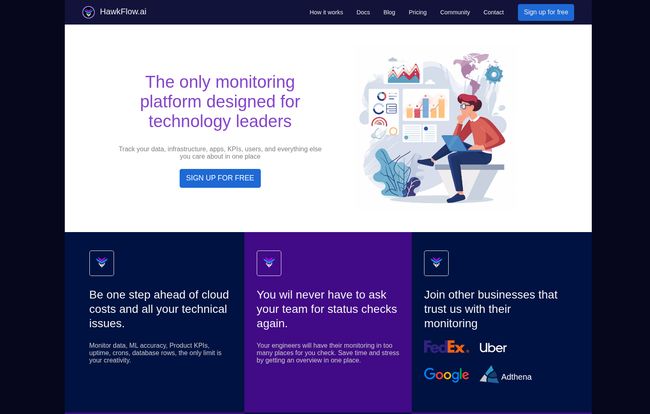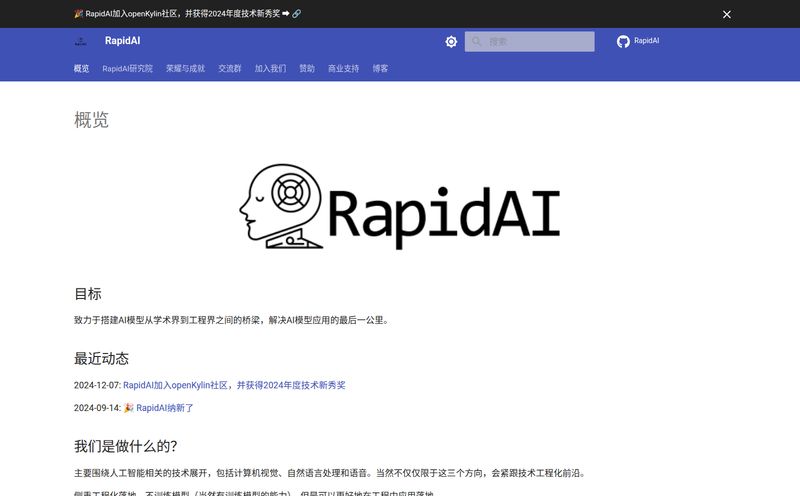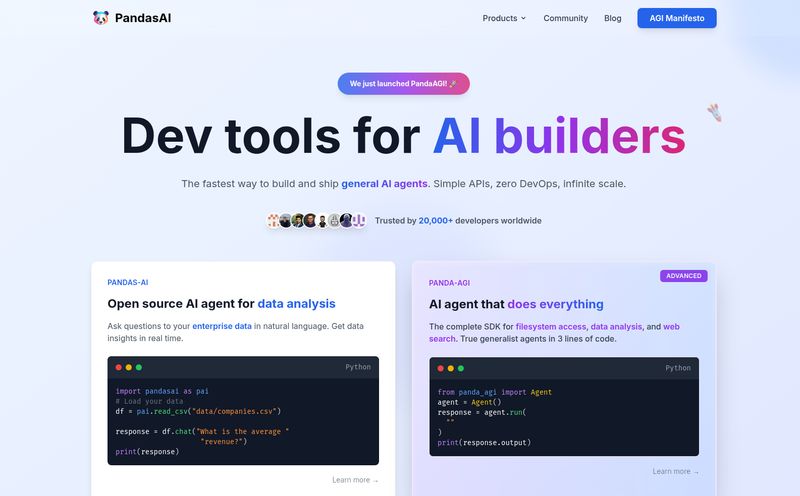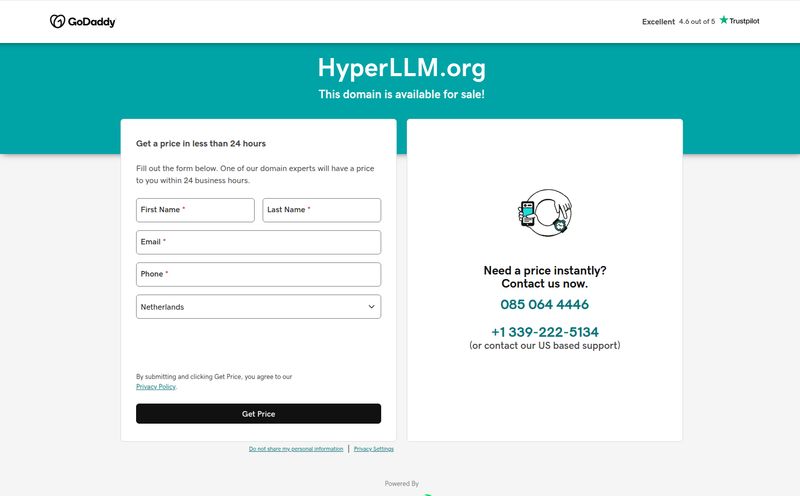If you're in the data science or MLOps space, you know the feeling. You build a beautiful model. It passes all the tests. You push it to production and… silence. Is it working? Is it quietly choking on weird production data? Is its performance slowly degrading over time? This quiet dread is the stuff of our nightmares. It's the classic "it works on my machine" problem, scaled up to an industrial-sized headache.
For years, monitoring has often felt like an afterthought, a clunky dashboard bolted onto the side of a project after the real work was done. But what if it was part of the code itself? What if you could get insights right from the development process?
I’ve been hearing some chatter about a tool called HawkFlow.ai that claims to be 'the only monitoring platform designed for technology leaders'. Big words. So, I decided to take a look and see if it's just marketing fluff or if there’s something genuinely interesting going on here. And I've got to say, I'm intrigued.
What Exactly is HawkFlow.ai, Anyway?
At its heart, HawkFlow.ai isn't just another performance monitor. It's more like a stethoscope for your code and data pipelines. It’s built on the idea that monitoring shouldn’t be a separate, painful step, but something you can weave directly into your code, your infrastructure, your business logic—basically, anything you can imagine.
The whole pitch is about moving monitoring 'left'—integrating it early into the development lifecycle. This means you’re not just waiting for things to break in production; you’re building a system that’s self-aware from the get-go. For data scientists, this is huge. It’s a way to track model accuracy, data drift, and processing times not as abstract metrics on a distant dashboard, but as living parts of your system.

Visit HawkFlow.ai
The Features That Actually Matter
A feature list is just a list. What I care about is how it solves actual, painful problems. And HawkFlow seems to have its sights set on some of the biggest pains in the MLOps world.
Automatic Anomaly Detection Is a Game Changer
One of the most tedious parts of setting up monitoring is defining what 'bad' looks like. You end up creating a million little rules and thresholds that quickly become outdated. HawkFlow’s promise of automatic anomaly detection is, frankly, a massive relief. Instead of you telling it when a run time is too long, it learns what’s normal and flags the weird stuff for you. This frees you up to focus on solving problems, not defining them. It’s the difference between having a smoke alarm and having a security guard who actually knows what’s out of place.
Simple Integration That Doesn't Require a PhD
I’ve seen so many powerful tools fail because getting them to work requires a month-long integration project and a dedicated engineer. The team at HawkFlow clearly understands this pain. The testimonials and documentation all point to a simple, code-based integration. It looks less like a full-organ transplant for your infrastructure and more like adding a powerful, well-documented library to your project. This low barrier to entry is probably its most strategic feature.
From Run Time Tracking to Apache Airflow
Timing your code is one of those things that sounds simple, but as one of their testimonials points out, it can be incredibly insightful. Seeing a process that used to take 2 minutes now take 20 is often the first sign of a deep, underlying problem. HawkFlow makes this trivial to track.
But what really caught my eye was the new Apache Airflow integration. For anyone running complex data pipelines, this is a huge signal. Airflow is the workhorse for so many data teams, and being able to monitor those DAGs and tasks seamlessly within HawkFlow shows they’re listening to the needs of the modern data stack. It’s not a static tool; it’s growing in the right direction.
What Are People Really Saying?
I’m always a bit cynical about curated testimonials on a homepage, but these ones are pretty specific, which I like. They don’t just say "it's great."
"I did not realise how insightful timing code could be. You have to try it." - Daniel Woolock, Engineering Manager
This hits the nail on the head. It’s about uncovering the 'unknown unknowns'.
"HawkFlow helps us see all other MLOps solutions that I have tried." - David Eszteleky, Founder of Data Science
This is a bold claim, but it speaks to the frustration with overly complex, siloed tools. A single, integrated view is a powerful thing.
"I did not know tools like this existed…" - Noah Weatherby, Group Product Manager
This one resonates the most with me. It suggests HawkFlow is carving out a slightly different niche—making this level of integrated monitoring accessible in a new way.
The Elephant in the Room: HawkFlow.ai Pricing
Alright, let's talk money. Or, in this case, the promise of money. Right now, HawkFlow.ai has a very clear pricing strategy: a super generous free plan, with paid subscription plans labeled "Coming Soon."
This is both its biggest strength and its main question mark. On one hand, you can get started for free, with no credit card, and get a ton of value. On the other, if you're a larger team looking to adopt this and scale immediately, the lack of defined paid tiers might give you pause.
| Plan | Details |
|---|---|
| Free Plan | 15,000 API calls per month, 500 API calls per 24hrs, Up to 5 users, Community Access, Unlimited email support. |
| Developer, Teams, Enterprise | Coming Soon |
My take? The free plan's limits (15,000 API calls/month) are more than enough to monitor a key project, run a proof-of-concept, or for a startup to get off the ground. For serious, high-volume production systems, you'll need those paid plans. Getting in on the ground floor of a tool like this can be a huge advantage, though. You get to grow with the platform.
The Good, The Bad, and The Code-Level Truth
So, lets break it down. No tool is perfect, right?
The good stuff is obvious. It’s developer-first, the integration seems genuinely simple, and the focus on automatic anomaly detection is smart. The free tier is a massive plus, making it a no-risk proposition to try. This feels like a tool built by people who have actually felt the pain of production monitoring.
The not-so-good stuff, for now, is the uncertainty. What will the 'Developer' and 'Teams' plans cost? When will they launch? For a large company with a rigid budget cycle, this might be a blocker. The API limits on the free plan are a real constraint you'll have to design around until paid plans are available, which is fair enough.
So, Is HawkFlow.ai Worth Your Time?
In my opinion, yes. Absolutely. Especially for certain groups.
If you are a data scientist, an MLOps engineer, or a tech lead on a small to medium-sized team, you should sign up for the free plan today. Seriously. It’s a low-risk way to see if this monitoring philosophy—this idea of weaving observability into your code—can give you the insights you're currently missing.
If you're a large enterprise looking for a solution to roll out across 50 teams tomorrow, you might want to reach out to them directly to understand their roadmap. But even then, having one of your R&D teams experiment with the free plan seems like a smart move.
This isn’t just another tool. It represents a shift in how we think about the health of our systems. It's proactive, not reactive. And for anyone who’s ever been paged at 3 a.m. for a silent failure, that’s a very appealing idea.
Frequently Asked Questions about HawkFlow.ai
- What is HawkFlow.ai used for?
- HawkFlow.ai is a monitoring tool primarily for data scientists and technology teams. It's used to track code performance, detect anomalies in data and models, monitor infrastructure, and get alerts on exceptions, all by integrating simple code into the development process.
- Is HawkFlow.ai free?
- Yes, HawkFlow.ai has a generous free plan that includes 15,000 API calls per month for up to 5 users. This is a great way to get started. They have announced that paid subscription plans for higher usage are coming soon.
- Who should use HawkFlow.ai?
- It's ideal for data scientists, MLOps engineers, and software developers who want to build more observable systems. Any team that runs critical data pipelines, machine learning models, or background jobs can benefit from its proactive monitoring approach.
- How does HawkFlow.ai compare to other monitoring tools?
- Many traditional monitoring tools focus on infrastructure (like CPU and memory) or application performance monitoring (APM) in a more detached way. HawkFlow’s key difference is its emphasis on simple, code-level integration, allowing you to monitor literally any process—from a business KPI to a specific function's run time—with the same tool.
- What is Apache Airflow and why is the integration important?
- Apache Airflow is a popular open-source platform for orchestrating complex data workflows. The HawkFlow.ai integration is important because it allows data engineers to easily monitor the health, duration, and success of their data pipelines directly, catching issues before they impact downstream processes.
Conclusion
HawkFlow.ai is a genuinely interesting player in the monitoring space. It's ambitious, developer-friendly, and focused on solving a real, persistent problem in a smart way. By moving monitoring into the code itself, it has the potential to give teams a level of insight that traditional tools can't easily provide. The current pricing model makes it a no-brainer to experiment with. Go ahead, give the free plan a spin. What have you got to lose, except for that quiet dread of silent failures?



